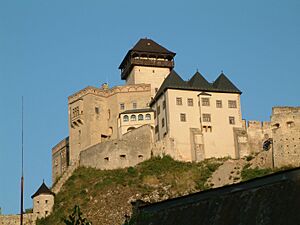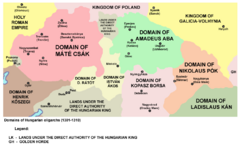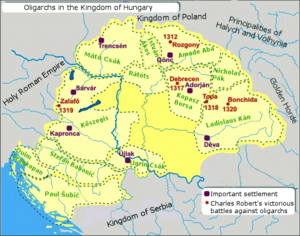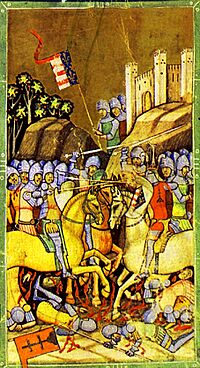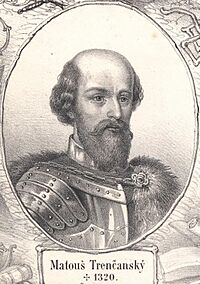Matthew III Csák facts for kids
Quick facts for kids Matthew III Csák |
|
|---|---|
|
|
|
| Reign |
|
| Predecessor |
|
| Successor |
|
| Issue | |
|
|
| Noble family | gens Csák |
| Father | Peter I |
| Mother | Unknown |
| Born | between 1260 and 1265 |
| Died | 18 March 1321 (aged 56–61) |
Matthew III Csák (born between 1260 and 1265, died March 18, 1321) was a very powerful Hungarian lord. He was so strong that he ruled a large area of medieval Hungary almost like an independent king. This area is now mostly in western Slovakia and parts of Northern Hungary.
Matthew Csák held important jobs like master of the horse (1293–1296), palatine (1296–1297, 1302–1309), and master of the treasury (1309–1311). Even after losing a big battle against King Charles I of Hungary, he kept control of his lands. Later, in the 1800s, people in both Hungarian and Slovak stories saw him as a symbol of fighting for freedom.
Contents
Early Life and Family
Matthew Csák was the son of Peter I Csák, who was also a palatine. His family, the Csák clan, was one of the most important families in Hungary.
Around 1283, Matthew and his brother, Csák, inherited lands from their father. These lands included Komárom (now Komárno) and Szenic (now Senica). They also inherited lands from their uncles, Matthew II and Stephen I, near Topoľčany, Hrušovo, and Tata. Their father had already started to expand his family's influence in the areas around their properties.
Matthew was born sometime in the 1260s. Records show he had a limp, possibly from birth or a war injury. After his father died, a rival family, the Kőszegis, grew stronger. They took advantage of the Csák family being weaker and even captured Pozsony Castle for a short time.
Serving King Andrew III
In 1291, Matthew joined King Andrew III of Hungary in a military campaign against Austria. The next year, when Nicholas I Kőszegi rebelled against the king, Matthew helped the king. He successfully recaptured castles like Pozsony (now Bratislava) and Detrekő (now Plavecké Podhradie).
After this, the Danube River became a border between the lands controlled by the Kőszegi and Csák families. King Andrew made Matthew the master of the horse and also the leader (called ispán) of Pozsony County from 1293 to 1297. In 1293, Matthew promised to respect the freedoms of the people living in Pozsony, which the king had already approved.
During this time, Matthew began to get more land, not just from the king but also by force. In 1296, he bought Vöröskő (now Červený Kameň Castle) from its owners. However, he also forced many nearby landowners to give their properties to him or his supporters. He even took lands from the Pannonhalma Archabbey and the Collegiate Chapter of Pressburg.
Around 1296, Matthew took control of Trenčín Castle. From then on, he was often called "Matthew Csák of Trencsén." King Andrew made him Palatine in 1296, a very high position. But soon, their relationship worsened. The king took away Matthew's Palatine title in 1297 and gave Pozsony County to his queen.
Becoming a Rival to Kings
Even after 1297, Matthew still called himself Palatine. He defeated Andrew of Gimes, a rival, and expanded his power along the Žitava River.
In 1298, King Andrew III made an alliance with King Wenceslaus II of Bohemia. This alliance was probably aimed at Matthew, whose lands were between their two kingdoms. The next year, King Andrew sent his army against Matthew, but Matthew held his ground. Only Pozsony County was taken back by the king's supporters.
Before 1300, Matthew talked with representatives of King Charles II of Naples. He promised to support Charles's grandson, Charles I of Hungary, for the Hungarian throne. However, in the summer of 1300, Matthew visited King Andrew's court. King Andrew, the last male member of the Árpád family, died on January 14, 1301. After his death, many people claimed the throne. Matthew's brother, Csák, died without children, so Matthew inherited all his lands.
After King Andrew III died, Matthew first supported the Neapolitan prince, Charles. But soon, he switched sides and supported Wenceslaus III of Bohemia, the son of King Wenceslaus II. Matthew was at Wenceslaus's coronation in 1301. Wenceslaus gave him Trencsén and Nyitra counties, making Matthew the legal owner of all royal castles and lands in those areas. In the following years, Matthew took over lands from the Balassa family and captured several castles in other counties.
King Wenceslaus couldn't hold onto power and had to leave Hungary in 1304. By then, Matthew Csák had already stopped supporting him. Soon after, Matthew made an alliance with Duke Rudolph III of Austria against the Bohemian king. Although Matthew didn't join King Charles's side yet, his troops helped King Charles and Duke Rudolph in a campaign against Bohemia in 1304.
The struggles for the throne continued. On December 6, 1305, a new claimant, Otto III, Duke of Bavaria, was crowned King of Hungary. Matthew Csák did not accept King Otto's rule. His troops fought alongside King Charles's armies, who took some castles in the northern part of the kingdom.
On October 10, 1307, an assembly confirmed King Charles's rule. However, Matthew Csák and other powerful lords did not attend. In 1308, Pope Clement V sent a special representative to Hungary to help King Charles. This representative, Cardinal Gentile Portino da Montefiore, convinced Matthew to accept King Charles's rule in November 1308. Matthew sent his representative to the assembly in Pest that confirmed King Charles's reign. Soon after, King Charles made Matthew the Palatine again.
However, Matthew didn't fully accept the king's authority. He was only represented by one of his followers at King Charles's new coronation in 1309. The next year, King Charles made him master of the treasury, which was a very important job at the time.
Matthew Csák still didn't want to follow the king's rule. He didn't attend King Charles's third coronation in 1310. Instead, Matthew kept expanding his own lands and took more castles in the north. On June 25, 1311, he led his troops to Buda and raided the surrounding areas. Because of this, Cardinal Gentile officially removed him from the church (excommunicated him) on July 6, 1311. But Matthew ignored this punishment and even forced some priests in his lands to continue their services.
Matthew then attacked the lands of the Archdiocese of Esztergom. When the citizens of Košice killed Amade Aba, another powerful lord in the northeast (September 5, 1311), Matthew made an alliance with Aba's sons against the king. The king sided with Košice. Matthew's troops helped free Šariš Castle, which the king was besieging. Then they marched against Košice.
At the Battle of Rozgony on June 15, 1312, the king's armies defeated Matthew's troops and his allies. After the battle, the king took over the lands of Amade Aba's sons. Matthew's own lands remained untouched, but the king's control of the nearby areas stopped Matthew from expanding further.
Final Years and Legacy
In 1314, the king's armies invaded Matthew Csák's lands, but they couldn't fully conquer them. Meanwhile, Matthew took some fortresses in Moravia. So, King John of Bohemia also invaded Matthew's territory in May 1315. The Czech army defeated Matthew's troops at Holíč, but they couldn't capture the fortress. King Charles also invaded Matthew's lands and took Visegrád.
King Charles I continued to launch small attacks against Matthew's lands in 1314 and 1315. When Matthew invaded Szepes County and his troops looted the area, he was defeated by Philip Drugeth, a loyal soldier of the king. The king slowly surrounded Matthew's territory by appointing loyal castle commanders to nearby forts.
The king also tried to weaken Matthew's supporters through diplomacy. In September 1315, King Charles I took away all the possessions of three of Matthew's followers. He gave these lands to Palatine Dominic II Rátót, because these followers completely supported Matthew Csák and didn't ask for the king's forgiveness. One of these nobles was Felician Záh, who later tried to assassinate the entire royal family in 1330.
In 1316, some of Matthew's former followers rebelled against him. Although he captured their castle at Jókő, some of them left his domain. In 1317, he attacked the lands of the Diocese of Nitra and his troops occupied and looted its main city. As a result, Bishop John again removed Matthew and his followers from the church.
The king's armies continued to invade Matthew's lands and took Sirok and Fülek (Fiľakovo). But Matthew managed to keep control of his main territories until he died in 1321.
Matthew's Domain
Matthew Csák's territory grew steadily before the Battle of Rozgony. It reached its largest size around 1311. By then, he and his followers controlled 14 counties and about 50 castles in the kingdom.
Around 1297, he set up his own court, much like a king's court. He took over royal powers in his lands, just like other powerful lords of that time. He became the real ruler of his domain and made alliances without the king's permission. He refused to let people appeal to the king against his decisions. He also stopped people from taking possession of lands that the king had given them if those lands were in his territory. Even though some local landowners didn't want to accept Matthew's rule, they eventually had to leave their properties.
After Matthew's death in 1321, his cousin Stephen Sternberg became the lord of his domain. This was because Matthew's son had died, and his grandsons were still too young. However, Stephen Sternberg couldn't stop the king's invasion. Matthew Csák's former domain was taken over by the king's armies within a few months.
Legacy in Slovak History
Matthew Csák had a big impact on the history of what is now Slovakia in the 1200s and 1300s. He founded new towns, especially in Trencsén County, and helped existing towns grow. The independence he achieved and his connections with the Czech lands also helped the local Slovak-speaking nobility develop. Even though he ruled for a relatively short time, his former domain was called "Matthew's Land" as early as the 1300s. This idea lasted until the 1400s, with people still saying they were from "Matthew's Land" instead of using official administrative names.
This idea became important in the Slovak national revival in the 1800s. Matthew Csák became a part of Slovak national stories. Many Slovak poets and writers, like Ľudovít Štúr, wrote about him. In the romantic stories of the 1800s, he was seen as a Slovak national hero. People thought he defended Slovak interests or was even an uncrowned Slovak king. Matthew Csák and his "realm" became symbols of Slovak independence. They were used to connect his historical importance to the idea of a future Slovak nation. Ľudovít Štúr, a key figure in the Slovak national revival, wrote a poem where he presented Matthew Csák as a champion of Slovak interests. He suggested that Matthew built on the legacy of Great Moravia and predicted that the Slovak nation "will be free one day."
However, this idealized view was mostly held by a small group of Slovak thinkers and wasn't widely accepted by ordinary people. The idea of Matthew Csák as a Slovak national hero was questioned by other Slovak intellectuals in the late 1800s and early 1900s. It was finally disproven by Slovak historian Jozef Škultéty in 1923. Today, modern Slovak historians see Matthew Csák simply as a powerful feudal lord, an important regional figure, and the "Lord of Váh and Tatras."
Matúš Čák was hardly a Slovak patriot as some 19th century historians have claimed. He pursued the ordinary goals of a Hungarian magnate and never did establish a sufficiently well-defined territory or political organization to support any Slovak claims to a heritage.
—Anton Špiesz, Dušan Čaplovič, Ladislaus J. Bolchazy; Illustrated Slovak history: a struggle for sovereignty in Central Europe (2006).
See also
- Beckov Castle – a castle owned and strengthened by Matthew Csák
- Amade Aba – another powerful lord who ruled parts of Hungary almost independently
- Ladislaus Kán – a lord who governed parts of Transylvania almost independently


